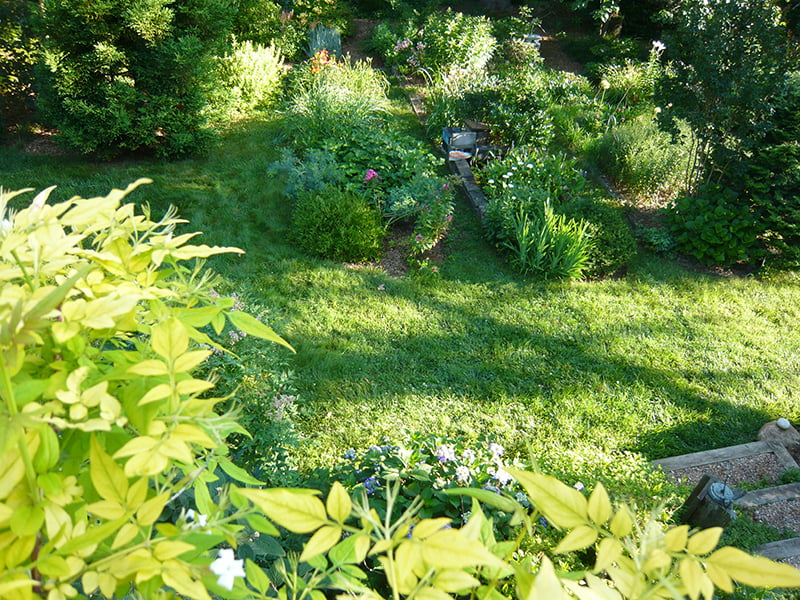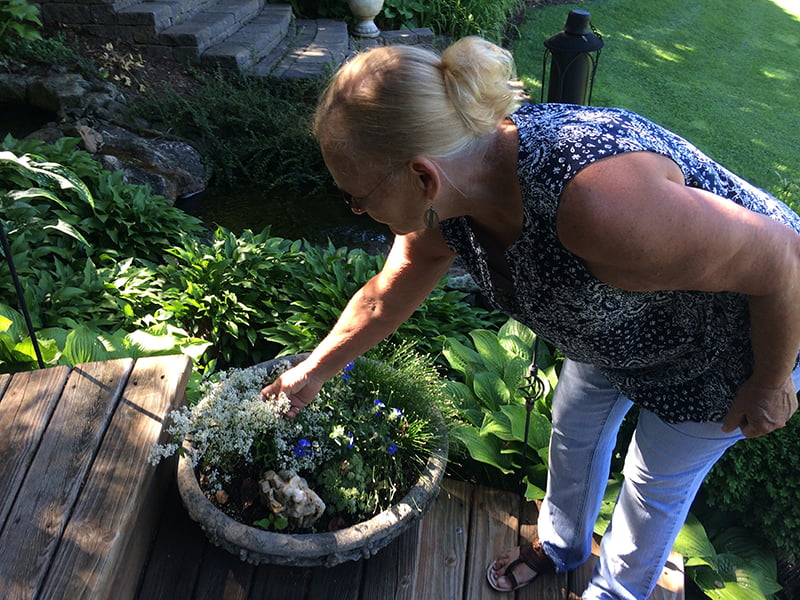
They are gardener’s gardeners, the seven men and women participating in the annual New River Valley Garden Tour 2019 this Saturday, July 6, opening their dappled lawns, sunny borders, shady paths, sweet gates and sweeping vistas, from 9 a.m. – 5 p.m. in rain or shine, for visitors to admire, learn or just stroll.
In an alliance that blends brains and beauty, much like a good garden, the tour is sponsored by the Friends of the Montgomery-Floyd Regional Library and the New River Valley Master Gardeners’ Association.
Two public gardens, Beth’s Garden at The Montgomery Museum of Art & History (300 S. Pepper Street) and its neighbor, the hidden gem at St. Thomas Episcopal Church (103 E. Main Street) both in Christansburg, will be open.
Also on the tour is the six-acre Unitarian Universalist garden (1301 Glade Road) in Blacksburg. Bonnie Moreno helped design its labyrinth and meditation path. This year, her own garden is on the tour.
“I do love sharing it,” she says from the basil and fuschia-filled balcony above her Christiansburg oasis. “It’s one of the reasons I’m doing this. I think, if you do all that work you want to share it.”
Viewed from the balcony, her intensely managed garden is heavily productive. Edibles and ornamentals surround the pink brick, Carson Drive ranch beneath airy willow oaks.
She has worked in this garden for 30 years, but has gardened much longer.
“Actually, I’ve been gardening since I was four. So, that’s 76 years. My mom had a victory garden. She took me out into it when I was four years old and she loosened the soil and said to me, “Now, put your hands down in there, now pull ‘em up and what do you find?” It was potatoes!” That soil was warm and friable. I know that was the beginning for me.”

Hers is a garden of gifts and surprises. A dogwood grove is a gift from robins. A towering river birch began as an Arbor Day whip, in a pool of rhododendrons, azaleas. In the dappled light, jack-in-the-pulpit and wild ginger grow in the loam thinking it’s a woodland.
“In this garden you need to stop and lift your head up. Look up,” she says.
Gardens are full of history and culture. Throughout the tour, knowledgeable gardeners and assisting Master Gardener volunteers will be on hand for advice and conversation.
“A cucumber magnolia, called Yellow Bird,” Moreno said pointing out the goblet-shaped tree. “In the spring, the buds fill the trees and look like yellow birds. And that’s serviceberry. It’s also called shadblow, because it blooms in the spring when the shad are coming up the river. That’s sweet woodruff. They used to use it to stuff mattresses. It smells good.”
Utility and beauty, fat green grapes drape a fence along the drive, blueberries, raspberries, rhubarb, and the surprise of gooseberries, rarely seen nowdays, good, says Moreno, for gooseberry cheesecake and a nice chutney.
Paths wind through ferns and solomon seal to a pretty koi pond and arrowleaf full of bees.
“I come out in the evening – I planted that jasmine for shade – for an hour after gardening. It’s my alone time.”
Like the Moreno garden, Willow Springs Farm emphasizes the pleasure of working in the garden.
Willow Springs is just off Pepper’s Ferry Road, but its maple-lined drive winds along a ridge above the tree farm’s ranks of blue spruces and red bud spilling away toward the New. Rabbits lope along the drive to the wood and stone house.
“I just have regular stuff that anybody can do,” Debbie Miller at the Willow Spring Farm stop on the tour. Standing in the balletic shade of Japanese maple, a leopard frog plonking like a banjo into the pond by her house’s front door.
“You don’t have to have showy flowers and all that,” she says, “to have a gorgeous garden.”
She sources from the meadows with a painterly eye that’s inspired by British garden designer, artist, and writer Gertrude Jekyll.
“My garden is like a musical score. You will see things repeated and if they look good together and they look good together, I just say great.”
Miller, like Jekyll, works in borders and pools mounds and spires of pale pink saponaria in the sunny borders, golds and blues in views down the valley of the tree farm’s ranks and rows.
Around the corner, beneath Norway spruces standing like druids, a boulder wall sprouts allysum and daylilies and a bijou deck full of potted rosemary by the grill and a gurgling pond.
“People like to be near each other,” Miller says of the intimate patio. “For more people we just pull out the big table onto the grass, a white cloth and 12 chairs and people will sit out there ‘til midnight.”
Part of a Master Gardener message and the key to a healthy garden is to choose plants that like to grow where you plant them.
“There’s nothing super expensive here or exotic. It’s affordable. Ten minutes a day gardening over a long period of time. It’s to be enjoyed, not to be ruled by it.
Every morning I grab a cup of coffee and the dog and do a little walk. I’ll weed a little bit.”
In it for the long-haul, with an ease and flexibility and learning what goes where are all part of the Master Gardener message of sustainability and this year’s gardens present seven personal palettes that carry that message.
There are 88,000 volunteer Master Gardeners in the U.S. and Canada who receive horticulture rigorous training – NRV Master Gardeners through Virginia Tech, then they extend that science based knowledge by giving lectures, creating gardens, conducting research, and holding plant clinics giving regionally specific advice.
There’ll be a NRVMG plant clinic tent – and gelato – at the Willow Springs Farm garden in Radford.
For more information, visit www.mfrlfriends.org/wp/garden-tour/


